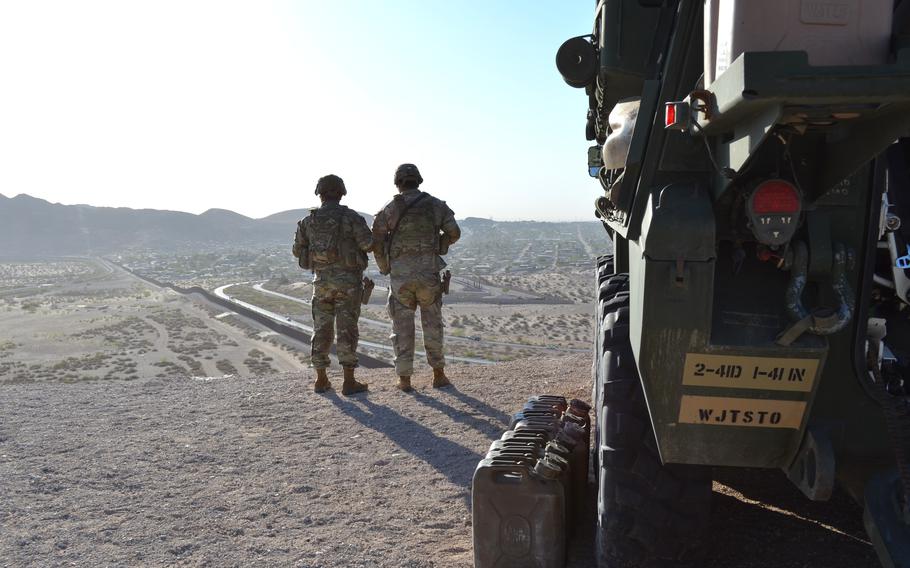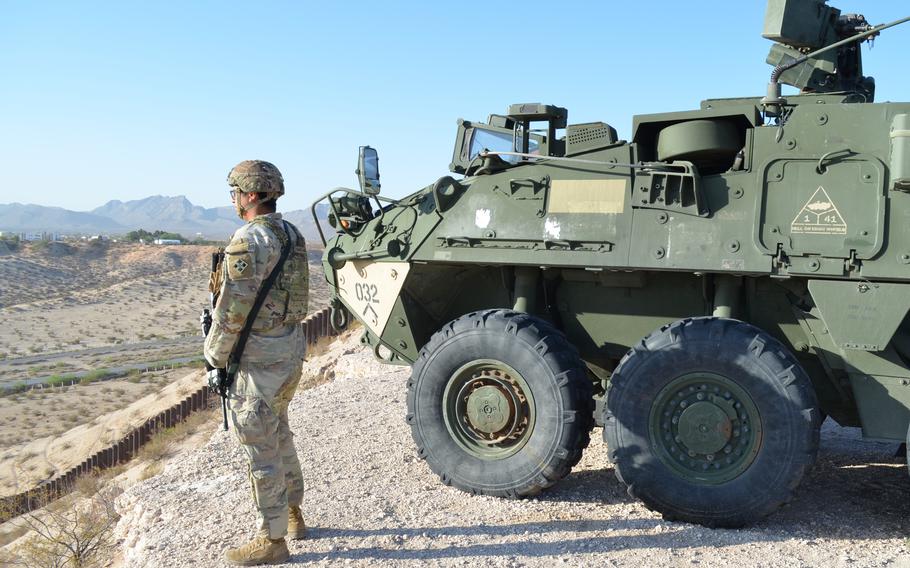
Sgt. 1st Class Carlos Zamora and Pfc. Gerardo Casarez-Aguilar, both assigned to the 2nd Brigade Combat Team of the 4th Infantry Division at Fort Carson, Colo., on April 11, 2025, as they look at the U.S. border with Mexico in Sunland Park, N.M., where their unit is assigned to the detect illegal activity. (Rose L. Thayer/Stars and Stripes)
EL PASO, Texas — In the month that Army Sgt. 1st Class Carlos Zamora has been deployed from Fort Carson, Colo., to the border with Mexico, he has seen the number of migrants trying to cross into the U.S. without authorization dwindle.
Zamora, a noncommissioned officer for the 1st Battalion of the 41st Infantry Regiment, said Friday that he supervises soldiers operating two Stryker combat vehicles positioned in Santa Teresa, N.M.
But for the Strykers used at the border, the weapon normally mounted atop the vehicle has been removed, leaving only its camera to monitor a two-mile radius that spans the dusty desert junction of New Mexico, El Paso and the Rancho Anapra neighborhood of Juarez, Mexico. The Strykers maintain a fixed position, though the troops have permission to conduct mobile patrols, if needed.
“[Strykers are] built for this kind of terrain,” Zamora said.
When soldiers see people moving near the border, they notify Customs and Border Protection agents with the precise distance and direction provided by the thermal camera mounted on the eight-wheeled armored vehicle. The images produced by the Stryker’s camera are so crisp and clear, soldiers recently detected and reported a group of men walking with guns strapped to their backs, Zamora said.
But soldiers are seeing less activity at the border, and their calls to border agents of people moving in the area have dropped.
Still, the 2nd Brigade Combat Team of the 4th Infantry Division has another 1,000 soldiers waiting to join the 2,400 already deployed to the Joint Task Force Southern Border, the official name of the military mission.
An average of 5,100 migrants each day were crossing into the U.S. without authorization during President Joe Biden’s four years in office, said Landon Hutchens, spokesman based in El Paso for Customs and Border Protection. Those numbers began to drop in June when Biden changed a policy and blocked anyone with unauthorized entry into the country from seeking asylum.
The average number of migrants crossing during President Donald Trump’s second administration, which began Jan. 20, has dropped to 230 a day, Hutchens said.
“With the DOD on overwatch, it frees up our agents to work arrests,” Hutchens said. “Stronger enforcement denies the [Mexican drug] cartels their revenue stream, and money is power.”
Lt. Col. Chad Campbell, 1-41 Battalion commander, said Friday morning that soldiers have a good plan to fit into what federal agents at the border need of them and have the equipment on hand to scale up operations.
“We’re in a good spot. I think we have a great relationship with the Border Patrol agents to understand our responsibilities to detect, monitor and track suspected illegal activities to call those up so they can enforce the law,” he said.
By Friday evening, Trump issued an order that could change that work and put soldiers in the role of enforcing the law.
The order calls for a military-owned buffer zone along the southwest border that would enable troops to detain people for trespassing onto military property — just as they would any other military base. Troops are not authorized to conduct law enforcement activities in a civilian setting under a law known as the Posse Comitatus Act but this change in property ownership would create a loophole, according to Elizabeth Goitein, senior director of the Liberty and National Security Program at the Brennan Center for Justice at New York University’s School of Law.
The Defense Department is ready to assume “administrative jurisdictional authority in specific border areas,” according to a defense official who spoke on condition of anonymity. The move will improve the ability of troops to protect the border and maintain sovereignty.
“As with any DOD installation, the department will prevent unauthorized access to the area through an appropriately identified controlled perimeter to deny unlawful entry, disrupt threats, and deter criminal activities,” the official said Monday.
In the El Paso sector, which stretches from west Texas through the entire state of New Mexico, crossings peaked during the Biden administration at about 2,100 migrants a day looking to evade arrest instead of seek asylum, said Border Patrol Agent Orlando Marrero-Rubio, who has worked 16 years on the southern border.
Because of the unforgiving terrain, deaths also rose dramatically with agents rescuing 986 migrants in distress and recovering 176 who died during fiscal 2024, which ended in September, he said.
In a mountainous desert stretch of Santa Teresa that is sandwiched between a Catholic monument and a landfill, foot paths are etched into the landscape by thousands of migrants. The border wall here is inconsistent in size and nonexistent in some stretches because some land is privately owned.
Until recently, human smugglers would hide people in wooden shacks on the Mexico side of the border and then send groups through in waves to overwhelm the Border Patrol agents.
No suspected crossings came across the radio Friday morning as soldiers in two Strykers and several green-and-white Border Patrol trucks were surveying the land. Even the streets and homes in Mexico visible through the beams of the border wall were still for a mild, sunny spring morning.
Trump ordered the deployment of active-duty service members to the border on Jan. 20, the first day of his second term in the White House. Since then, roughly 6,600 soldiers and Marines have deployed between California and Texas — joining a mission that mostly included National Guard troops to support federal agents from Customs and Border Protection. The mission began during Trump’s first term in 2018 and continued under Biden.
The open-ended military presence in El Paso is a mirror of the work happening across the southwest border, said Lt. Col. Sarah Ray, spokeswoman for the 10th Mountain Division, which is the headquarters in charge of Joint Task Force Southern Border.
They’ve realigned the existing mission to have a military command post partnered with each Border Patrol command post to better match the needs of the federal agents. Military aviators and engineers are spread throughout.
“Joint Task Force Southern Border is committed to supporting our U.S. Border Patrol partners as long as directed by national leadership and consistent with mission requirements. Currently, we cannot provide a specific timeline for the units deployed,” she said.
Henry Ziemer, an associate fellow in the Americas Program at the Center for Strategic and International Studies, a Washington think tank, said Trump’s new order for military-owned land at the border is “experimenting with whether or not a more lasting U.S. military presence along the border is going to be helpful at controlling migration.”
“The armed forces are sort of seeing what they can and cannot do, and what works and what doesn’t right now,” he said. “I’m not a lawyer, but it seems like this will provoke some legal challenges. So we’ll see whether or not this policy remains in place.”

Pfc. Gerardo Casarez-Aguilar of the 2nd Brigade Combat Team, 4th Infantry Division at Fort Carson, Colo., looks out on April 11, 2025, at the U.S. border with Mexico in Sunland Park, N.M., where his unit is assigned to the detect illegal activity. (Rose L. Thayer/Stars and Stripes)
Another aspect of this mission is a desire from the Trump administration to set up a fight against Mexican drug cartels, Ziemer said. One of the many immigration-related orders signed by Trump on his first day in office included one to label drug cartels as foreign terrorist organizations.
“From that perspective, I could see, even with decreased traffic across the border, still wanting to scale up your intelligence collection [and] security enforcement capabilities to combat drug trafficking,” Ziemer said. “That sort of criminal activity remains a persistent challenge.”
Hutchens said Friday that smugglers and cartel members on the Mexican side of the border would throw rocks and threaten Border Patrol agents, but they are far less likely to do so with military forces. Ziemer agreed with that assessment.
“The initial reaction seems to be that most Mexican cartels do not want to pick a fight with a soldier,” he said. “They don’t want to get into an actual shootout with U.S. military personnel because of a concern of what comes next given the sort of rhetoric [from the Trump administration].”
Speaking a week ago at the Central American Security Conference in Panama City, Defense Secretary Pete Hegseth thanked other countries for doing their part to crack down on migration toward the U.S., and said transnational gangs and drug cartels are profiting off the chaos it creates.
“Their existence threatens yours and our sovereignty. Together, each for our own country, we will target, and we will destroy those networks,” he said.
Meanwhile, the Stryker brigade from Fort Carson is ready to increase its capacity at the border. About 50 more Styker vehicles arrived by train just about a week ago and soldiers in a motor pool at Fort Bliss in El Paso were working Thursday to prepare them for action — removing the bubble wrap protecting equipment during transit and installing the cameras atop the vehicles.
Some are already slated to move east to the Big Bend region of Texas where it is far less populated, and national and state parks stretch along the border with Mexico.
Zamora was already familiar with the area before this deployment. He first came to El Paso in 2014 as a soldier assigned to Fort Bliss. He said, in those days, he never thought about the nearby border. This mission has changed his perspective.
“I didn’t realize how much crossing happens,” Zamora said. “Now doing this, I realize how much was happening in the El Paso sector.”